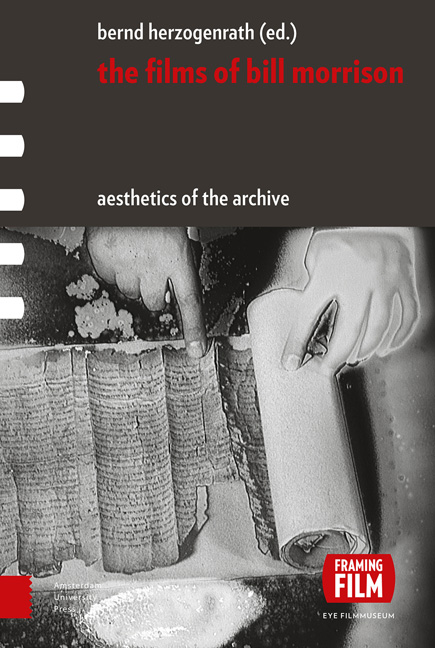Book contents
- Frontmatter
- Contents
- Acknowledgments
- Aesthetics of the Archive: An Introduction
- Chapter 1 Drafts and Fragments: Reflections around Bill Morrison and the Paper Print Collection
- Chapter 2 The Film of Her: The Cine-Poet Laureate of Orphan Films
- Chapter 3 Ghost Trip: Searching for Potential Myths
- Chapter 4 Decasia: The Matter | Image: Film is also a Thing
- Chapter 5 The Mesmerist: Illustrating the Return of the Repressed
- Chapter 6 Light is Calling: Celluloid Dreams
- Chapter 7 Gotham: Zoetrope: Block by Block
- Chapter 8 Outerborough: Early Cinema Revisited
- Chapter 9 The Highwater Trilogy: Thinking the Liquid – On the Ethics of Water and the Material Ecologies of Disaster and Ruination
- Chapter 10 Porch: Archives, Collective Memory, and the Poetics of Home Movies
- Chapter 11 The Future Lasts Long: The Romanov Lost Family Archives
- Chapter 12 Who by Water: Variations on Matter, Figures, Memory, and Mythology
- Chapter 13 Every Stop on the F-Train: Beyond and within the Restless Netherworld of (Manhattan’s) Mind
- Chapter 14 Spark of Being: Bachelor Machine
- Chapter 15 The Miners’ Hymns: Acts of Resurrection
- Chapter 16 Tributes – Pulse: A Requiem for the 20th Century: Death | Drive | Image
- Chapter 17 Just Ancient Loops: The Loops of Life in Intonation
- Chapter 18 The Great Flood: Water is Transparence Derived from the Presence of Everything
- Chapter 19 Re-Awakenings: Bill Morrison in Conversation
- Index of Film Titles
- Index of Names
- Index of Subjects
- Already Published
Chapter 5 - The Mesmerist: Illustrating the Return of the Repressed
Published online by Cambridge University Press: 12 December 2020
- Frontmatter
- Contents
- Acknowledgments
- Aesthetics of the Archive: An Introduction
- Chapter 1 Drafts and Fragments: Reflections around Bill Morrison and the Paper Print Collection
- Chapter 2 The Film of Her: The Cine-Poet Laureate of Orphan Films
- Chapter 3 Ghost Trip: Searching for Potential Myths
- Chapter 4 Decasia: The Matter | Image: Film is also a Thing
- Chapter 5 The Mesmerist: Illustrating the Return of the Repressed
- Chapter 6 Light is Calling: Celluloid Dreams
- Chapter 7 Gotham: Zoetrope: Block by Block
- Chapter 8 Outerborough: Early Cinema Revisited
- Chapter 9 The Highwater Trilogy: Thinking the Liquid – On the Ethics of Water and the Material Ecologies of Disaster and Ruination
- Chapter 10 Porch: Archives, Collective Memory, and the Poetics of Home Movies
- Chapter 11 The Future Lasts Long: The Romanov Lost Family Archives
- Chapter 12 Who by Water: Variations on Matter, Figures, Memory, and Mythology
- Chapter 13 Every Stop on the F-Train: Beyond and within the Restless Netherworld of (Manhattan’s) Mind
- Chapter 14 Spark of Being: Bachelor Machine
- Chapter 15 The Miners’ Hymns: Acts of Resurrection
- Chapter 16 Tributes – Pulse: A Requiem for the 20th Century: Death | Drive | Image
- Chapter 17 Just Ancient Loops: The Loops of Life in Intonation
- Chapter 18 The Great Flood: Water is Transparence Derived from the Presence of Everything
- Chapter 19 Re-Awakenings: Bill Morrison in Conversation
- Index of Film Titles
- Index of Names
- Index of Subjects
- Already Published
Summary
ABSTRACT
Morrison's cinema has often been associated with the passage of time and death: the grim inevitable, as it were. But what about dreams and murder? The Mesmerist (2003) stands out as an oddity in Morrison's oeuvre because it has a plot. Though it features the found art of decaying film, he takes the plot from the original source, The Bells (1926) by James Young, and uses decidedly modern techniques of film, rearranged fabula, abstract art, the modern jazz of Bill Frisell, to create a different kind of film without changing the core of the story on which his film is based. However, The Mesmerist maintains an integrity to the Morrison style because it still shows a concern for the unconscious.
KEYWORDS
The Bells, Bill Frisell, Boris Karloff, Lionel Barrymore
Because of the specificity of Bill Morrison's medium – decayed early-20th-century nitrate film and its abstract, kaleidoscopic expressiveness – a sense of the vital ephemeral quality of the images caught in a state of decay often becomes associated with the passage of time and/or as a metaphor for life and death. After all, his most famous work is his feature-length masterpiece Decasia: The State of Decay (2002). His oeuvre working with this material seems to thrive as abstract testament to its form and rarely can his films be judged on a clear narrative level. But then there is 2003's The Mesmerist, a short film Morrison created directly after Decasia.
With The Mesmerist, the filmmaker found a new context for decayed nitrate film. The film's startling bubbling quality reflects a different side of man. Instead of his mortality, it represents his corruption. The film also features Morrison's straightest narrative yet. The filmmaker said it himself in a 2006 interview with Senses of Cinema: ‘What's remarkable about “The Mesmerist”, and really sets it apart from anything else I’ve done, is that, not only have I borrowed the images, I’ve also borrowed the plot points. But I’ve reshaped the plot.’
The direct source materials for The Mesmerist are various reels of the 1926 silent feature by the American director James Young, The Bells. These reels include both a well-preserved print as well as several damaged reels of the same movie. All of it was provided to Morrison by the U.S. Library of Congress (Senses of Cinema).
- Type
- Chapter
- Information
- The Films of Bill MorrisonAesthetics of the Archive, pp. 97 - 108Publisher: Amsterdam University PressPrint publication year: 2017



